Target: All Tokyo Residents! How "Tokyo Disaster Prevention" Was Created (Part 1)
Since September 2015, the " Tokyo Disaster Prevention " booklet has been distributed to every household in Tokyo. Many of you have likely seen it. This time, we spoke with Ryosuke Sakaki, Design Strategist at Dentsu Inc.'s Creative Planning Division 3 (Dentsu Communication Planning Center), who oversaw the overall creative strategy and production for the "Tokyo Disaster Prevention" project, as well as the editing of the booklet portion.
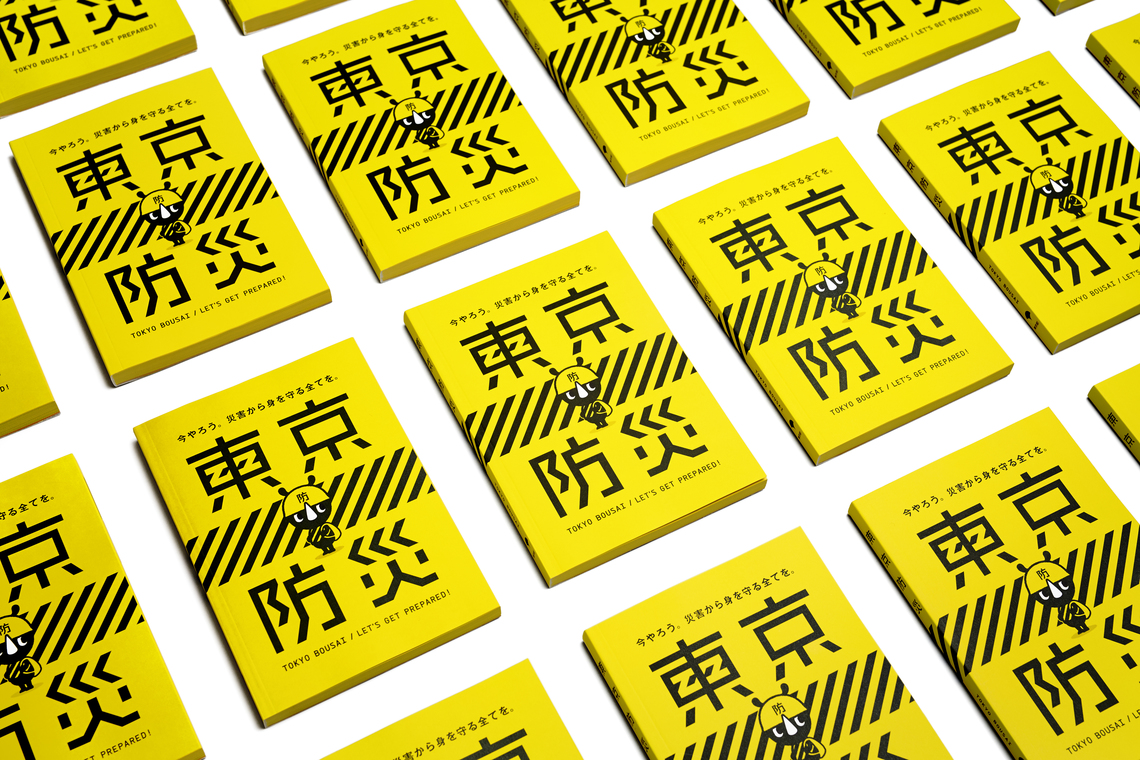
■This isn't a project that ends with distributing the book. It's about building disaster preparedness from there.
—First, how were you involved in the Tokyo Disaster Prevention project?
Sakaki: As a Design Strategist, I was involved in everything from planning and structure down to the smallest design details. Disaster prevention involves extremely important information that must be communicated correctly. However, materials previously distributed by the national government and municipalities often lacked design consideration or had overly rigid content, meaning the information wasn't effectively conveyed. For this project, we first envisioned the final design, then worked backwards to plan the details and translate them into the actual production.
The initiative itself began with Governor Yoichi Masuzoe's decisive action. During his student exchange in Switzerland, he was deeply impressed by how every household received a copy of a book titled "Civil Defense," promoting "citizen empowerment to protect themselves." This experience became the catalyst for this project.
When I heard about this project, I felt strongly that I had to be involved. I volunteered for the planning competition for this project, won it, and became part of the team. This is because I am from Takarazuka City in Hyogo Prefecture and was a victim of the Great Hanshin-Awaji Earthquake. I experienced buildings collapsing around my home and the school gymnasium becoming an evacuation center. In a major disaster, unimaginable events unfold one after another. Precisely because of this, disaster prevention information is critically important knowledge that everyone must possess to prepare for the major disasters that will inevitably occur in the future. I created this project with the conviction that it must be delivered to as many Tokyo residents as possible, using editing, design, and language that captures their interest and is easy to understand.
Furthermore, Tokyo Disaster Prevention also positions itself as part of Tokyo's city branding, representing a step toward "aiming to make Tokyo the world's number one disaster-prepared city."

—What were the goals in creating it?
Sakaki: From the proposal stage onward, we consistently emphasized that this project must not end with simply creating a book for people to read. Disaster prevention activities only succeed when they become part of residents' daily lives and are sustained over time.
To achieve this, Tokyo Disaster Prevention aims to enhance "disaster prevention capability." We define this capability as comprising three elements: knowledge, imagination, and unity.
Knowledge = Possessing (correct) disaster prevention knowledge.
Imagination = Being able to imagine what might happen during an actual disaster and how one should act.
Solidarity = Regularly discussing disaster prevention with those around you and being prepared to unite during a disaster.
Only when these three elements are present does it become "disaster preparedness capability."
■Get people to pick it up, imagine it, and take action. What kind of design is needed to achieve that?
—How did you translate the goal of "enhancing disaster preparedness" into the book's content?
Sakaki: First, our target audience this time is "all Tokyo residents." This includes people of all ages and genders, diverse lifestyles, varied regional characteristics—urban areas, mountainous regions, islands—plus individuals with disabilities, those requiring special consideration, foreigners, and every other segment.
No other city in the world boasts such diversity. And in this project, we cannot afford to overlook a single person. We developed our design and editorial policies with this in mind.
The fundamental premise is the significance of Tokyo using taxpayer funds to create this resource. Since numerous commercially available disaster prevention guides already exist, creating something identical would be meaningless. After thoroughly considering why this guide must be created now, we arrived at the conclusion that it must be exclusively tailored for Tokyo.
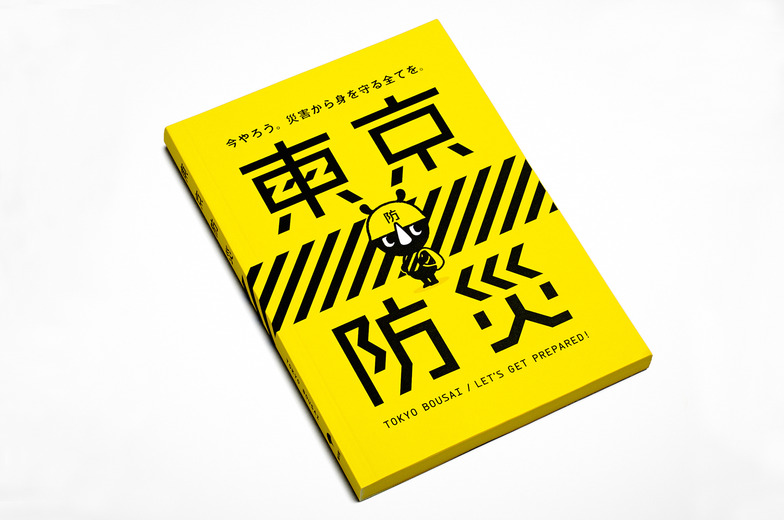
—What guidelines did the team share during production?
Sakaki: We established "Four Editorial Principles" and "Five Design Elements." Let me start with the four editorial principles.
The first is "Entertainment-Oriented." Disaster preparedness often feels rigid and heavy, right? That's natural because it requires imagining negative scenarios—disasters—and taking action. Humans instinctively avoid envisioning worst-case scenarios, so we need to create a system that helps people overcome that mental hurdle and proactively engage in disaster preparedness.
This book prioritizes two things: first, making it look interesting enough for people to casually pick it up and read, and second, ensuring they gain disaster preparedness knowledge without even realizing it.
To get people to pick it up, visually appealing design is crucial, and attention to appearance is evident throughout. Take "Bousai-kun," who appears on the cover. The impression is completely different whether this character is on the cover or not.
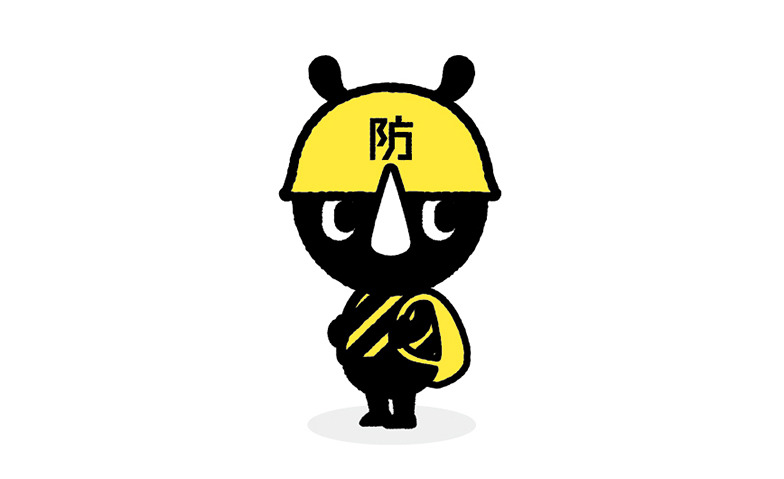
Then, the book's numerous illustrations. We've placed illustrations with a touch that's neither too stiff nor too soft, designed so that even just flipping through them conveys the message. Furthermore, we've included manga by the renowned manga artist Mr. Kawai Kaji. Manga is an easy-to-read format, serving as a hook to get readers to open the book and start reading.
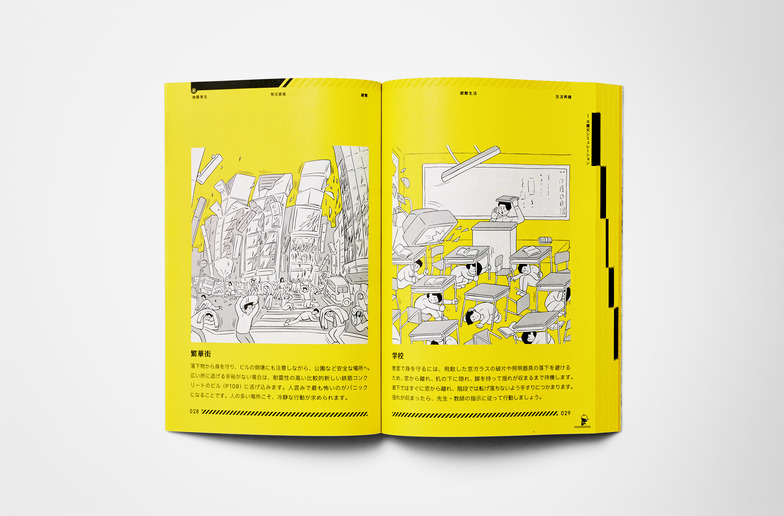
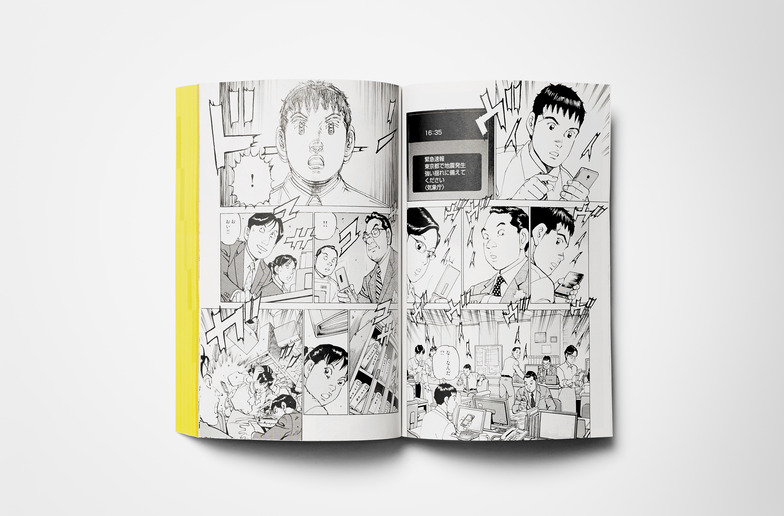
For finer details, we've added flip-book animations of Bousai-kun at the page edges. These animations follow the sequence from disaster onset to personal protection, securing exits, initial firefighting, and staying home—all helping readers gain disaster preparedness knowledge. We've also included quizzes and packed in many entertainment elements, aiming first and foremost to get people to pick up the book.
The second feature is its "disaster simulation experience." It aims to first make readers imagine an actual disaster and simulate how they would act if it happened now. The manga's story depicts the moment a major disaster strikes during an ordinary, everyday scene, creating a strong sense of reality that it could happen right now.
Chapter 1 is entirely a simulation, covering the entire sequence of events: the disaster's onset, the immediate aftermath, evacuation, life in evacuation shelters, and recovery. The section titled "Facing Death" also addresses the sensitive topic of death. Very few disaster prevention books, whether by private or public organizations, address death. While some argued that, considering the wide readership, it was better not to include provocative material, we included it because fostering a genuine sense of crisis and personal connection is more likely to lead to action. The structure ensures it doesn't end with just a shocking story; it continues with the recovery narrative, connecting to the future.
Third is the "Call to Action" approach. A major disaster could strike tomorrow. That's why taking action "now" is crucial. The project's slogan is "Do it now." Key sections in the book that prompt immediate action are marked with a "Do it now" symbol. Busy readers may struggle to read everything, so we designed it so that reading only the marked pages still builds essential disaster preparedness skills.

Furthermore, we've included "Disaster Preparedness Workshops" designed to spark discussions within families and communities. A common oversight in disaster preparedness is "communication readiness." By holding workshops, we aim to strengthen relationships within families and communities.
The book also includes many pages designed for writing notes, and the included disaster preparedness map follows the same approach. The compact map is meant to be carried at all times, allowing users to write down family information, contact details, evacuation sites, and more. By incorporating the "writing" process, it creates an opportunity for families to gather and realistically consider disasters.
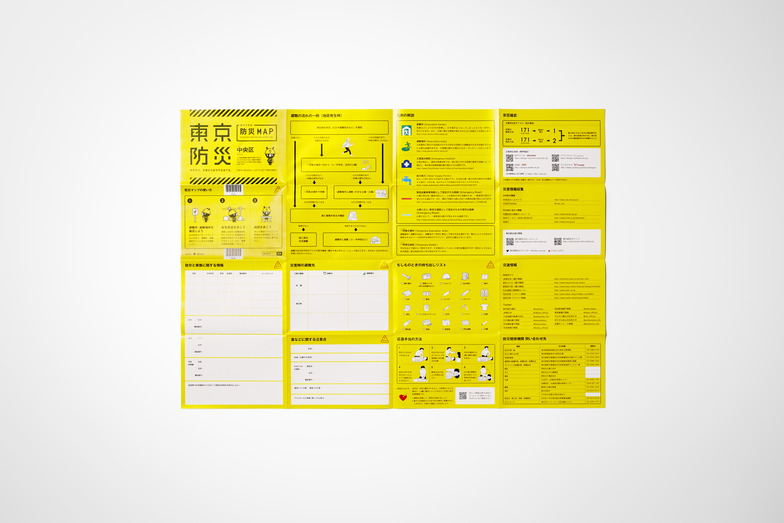
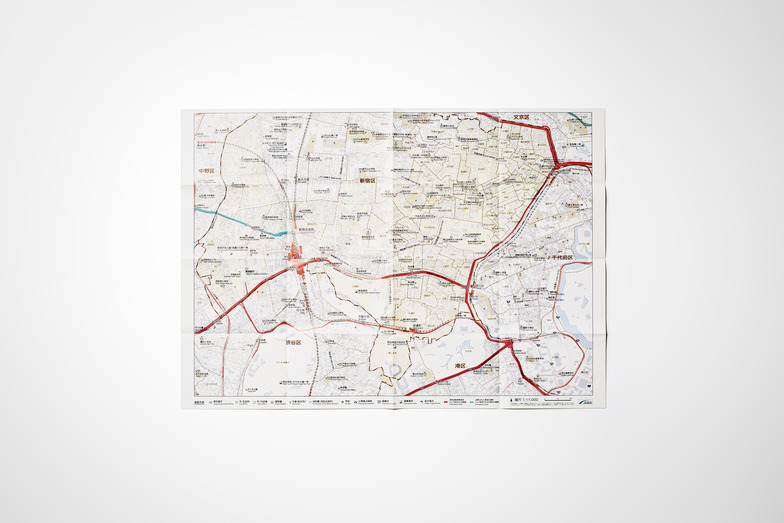
Fourth, it is thoroughly "Tokyo-specific." We analyzed the lifestyles and urban structure of Tokyo residents in depth, aiming to create a guide that can be applied anywhere in the city.
Guided by the universal design principle of "leaving no one behind" in Tokyo's diverse community, we've obtained two certifications. One is the CUD verification from the Color Universal Design Organization, focusing on visibility and clear color schemes. The other is the UCDA certification from the Universal Communication Design Association, which checks text readability and clarity of communication.
■Maximizing impact with minimal elements. Design meticulously crafted down to the smallest detail
—So it's created with an editorial policy focused on meticulous detail. Could you tell us the key design points? What are the five design elements?
Sakaki: First, we felt this design shouldn't be overly stylish. Since it's distributed to all Tokyo residents, imagine if it arrived at an elderly man living alone. A design that looks too trendy might make him think, "This was delivered by mistake," and he might not even look at it. That's why we were particularly focused on the design of the mailing package. While the impact upon arrival is important, we also wanted to retain the feel of an official government distribution. And we wanted people to want to open it. We aimed for a design that everyone could feel was meant for them.
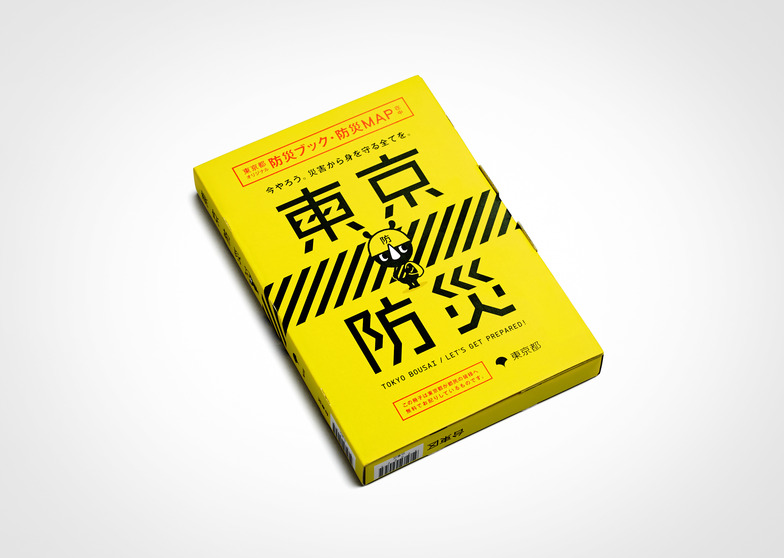

Regarding the five design elements:
① The name "Tokyo Disaster Prevention" was chosen to simply convey that it's Tokyo's disaster preparedness material, and the title was turned into an icon.
② The key colors are yellow and black. This combination is recognized globally as a warning color scheme, offering the highest visibility. It's calculated to catch the eye instantly, no matter where it lands in a room. The yellow also gives it a pop and bright feel.
③ As the key icon, we created the Disaster Prevention Stripe. It's a simple, easy-to-use common icon for the entire campaign. The yellow and black combination gives it an impression of danger.
④ Meet the character, Bousai-kun. He can appear at events and is everyone's idol. I drew him myself. Cute, right? (lol)
⑤ The catchphrase "Let's do it now." serves as the rallying cry for this movement urging action.
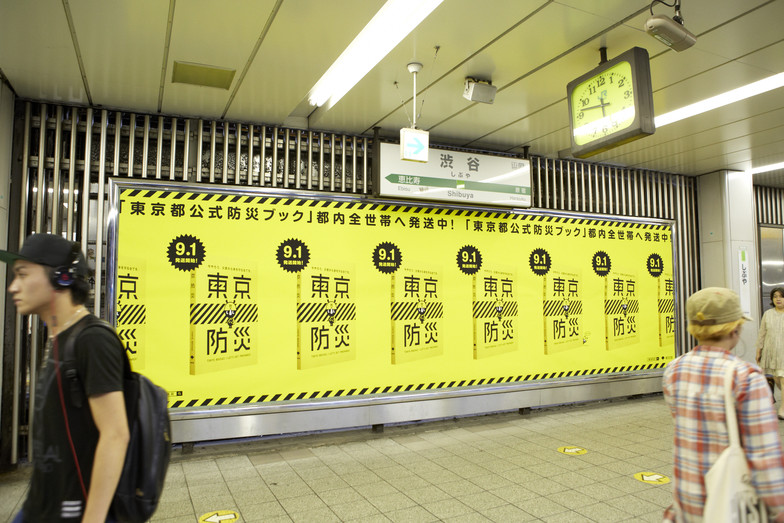
With these five design elements, we're designing not just the book but the entire project with a unified look. Our goal is to achieve maximum impact with minimal exposure.
Regarding the design, the design company "Nozainer" is deeply involved. We're creating it in close consultation with their excellent designers, including their representative design strategist, Mr. Eisuke Tachikawa, down to the finest details.
—The kickoff event also garnered significant attention.
Sakaki: It was planned primarily by Dentsu Inc.'s Event & Space Design Bureau. We featured Momoiro Clover Z and had Governor Masuzoe appear, holding the kickoff event at Tomin Plaza. While ordinary disaster prevention events often struggle to draw crowds, we aimed to engage people who aren't usually interested in disaster preparedness by featuring idols. We distributed T-shirts at the event, and photos of this spread widely on social media.
Next time, we'll discuss the specific production methods for this book and its future developments.
Was this article helpful?
Newsletter registration is here
We select and publish important news every day
For inquiries about this article
Author

Sakaki Ryosuke
Dentsu Inc.
Primarily serves as an art director overseeing advertising campaigns for various companies. Currently expanding his scope with the mission to "unleash the capabilities of advertising creators for society." Recent major projects include: the data food revolution "OPEN MEALS" project, which gained attention at SXSW; the development project for "Hokkaido Ballpark," scheduled to open in 2023; the disaster prevention book "Tokyo Bousai" project, distributed to all Tokyo residents; and the space food market co-creation project "space food X." Recipient of the Good Design Gold Award and other accolades including D&AD.

